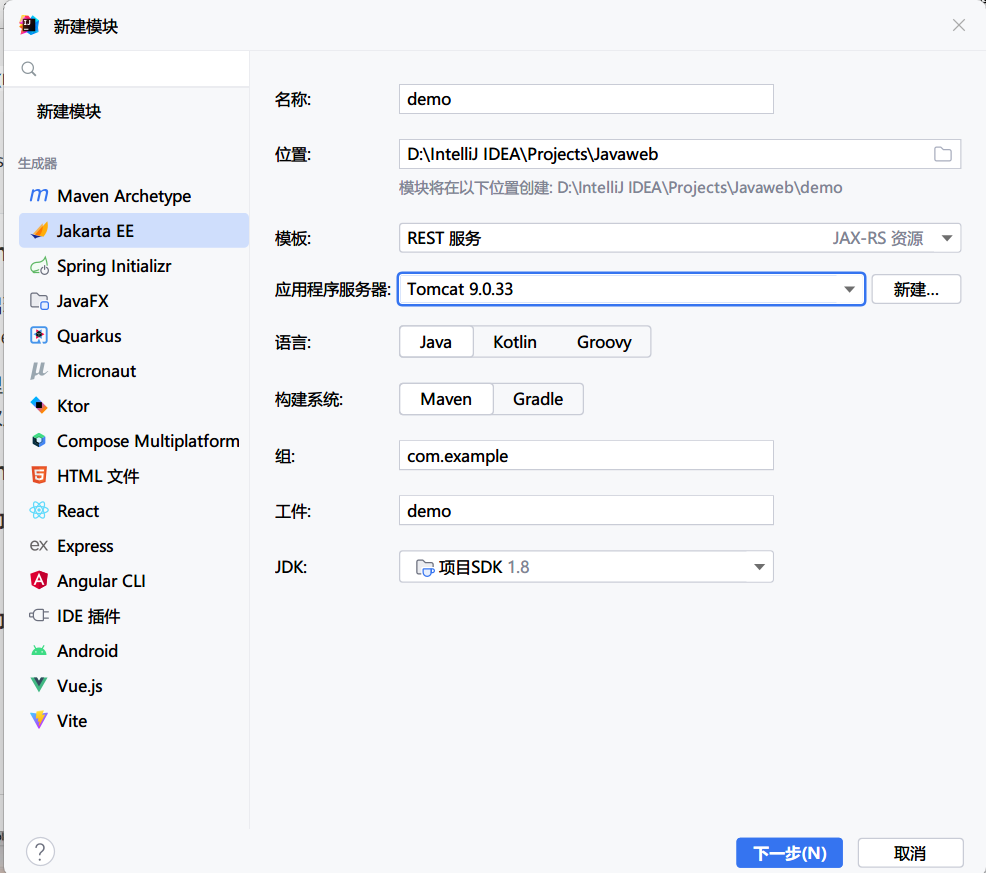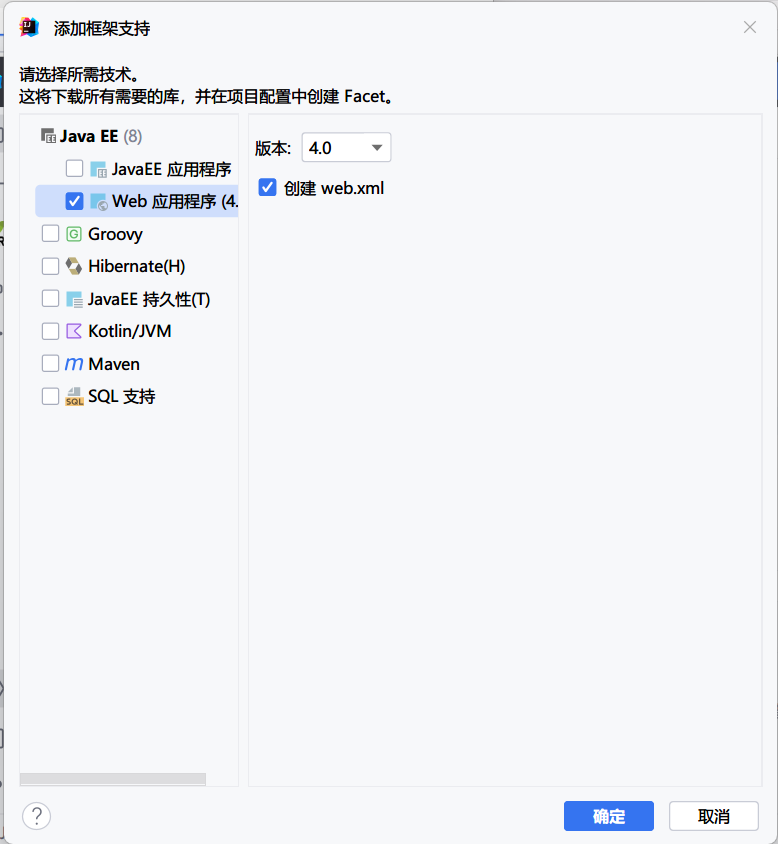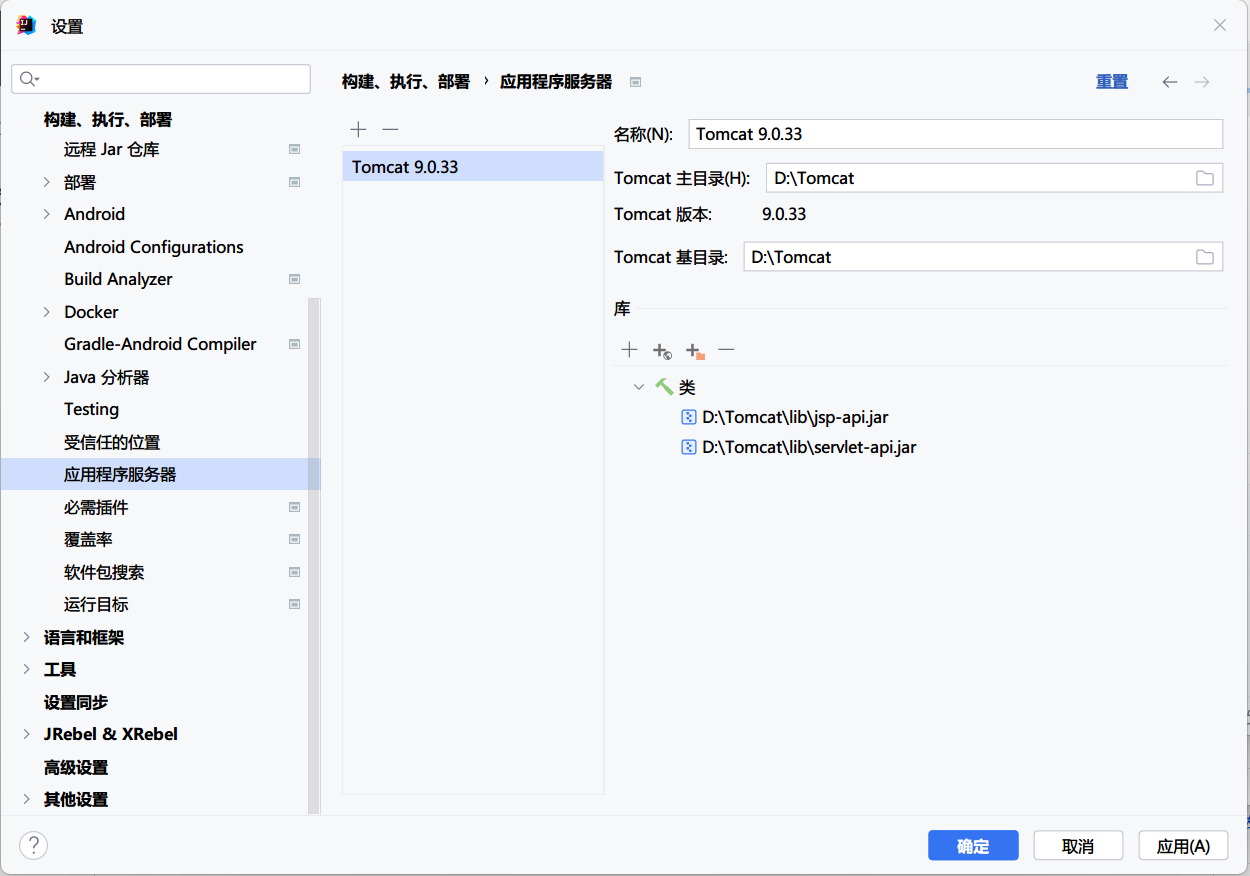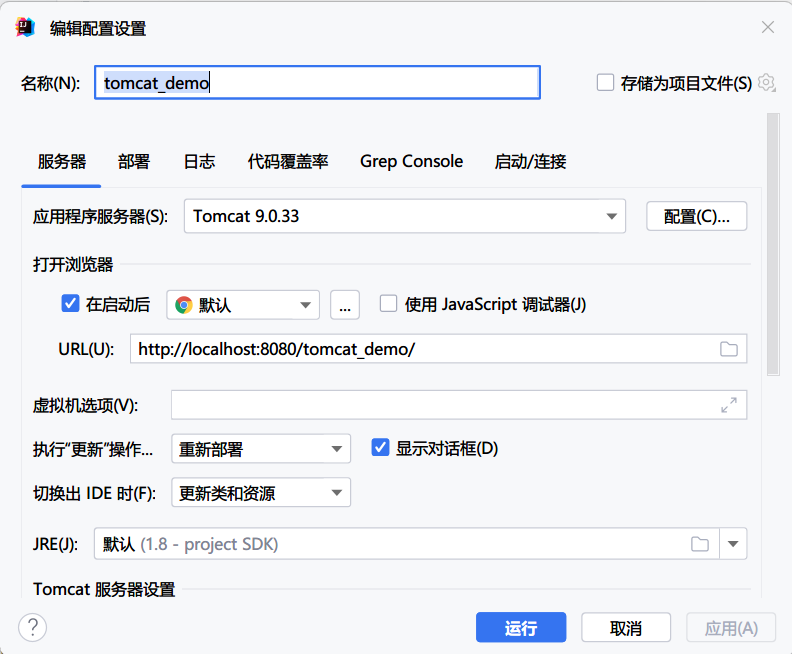JavaWeb的前期准备
一、概念
1.什么是javaWeb
JavaWeb指的是,java语言编写的可以通过浏览器访问的程序,统称为JavaWeb,它基于请求和响应。
2.什么是请求
请求指的是客户端向服务器发送数据,叫请求Request
3.什么是响应
响应是指服务器给客户端回传数据,叫响应Response
注意:请求和响应是成对出现的 , 有请求就会有响应
4.软件的结构方式
- B/S 浏览器 / 服务器架构
- C/S 客户端 / 服务器架构
5.Web资源的分类
-
静态资源:html、css、js等
-
动态资源:jsp页面、servlet程序、Vue
6.常见的Web服务器
Tomcat: 由 Apache 组织提供的web服务器,轻量级,提供了 jsp 和 Servlet 支持,应用最广的服务器
JBoss :javaEE规范、开源代码服务器
二、Tomcat
1.目录介绍
bin 存放服务器的可执行文件
conf 存放服务器配置文件
lib 存放服务器所选的jar
logs 存放的是日志信息
temp 存放的服务器的临时数据
webapps 部署web工程的目录
work tomcat的工作目录 jsp源码 session持久化目录
2.安装及配置Tomcat
运行后发现出现中文乱码,说明字符集不同,需要到Tomcat根目录下的conf子目录下的logging.properties文件里修改编码
将配置文件里的所有encoding = UTF-8都修改为encoding = GBK,使其识别中文,保存配置文件后,再次启动Tomcat解决中文乱码
3.集成Tomcat到IDEA
3-1.第一种:创建web项目

3-2.第二种:创建普通项目后添加框架支持

3-3.在IDEA里配置Tomcat

3-4.配置当前项目的Tomcat

三、XML
1.什么是xml
xml是可扩展的标记性语言
2.xml的作用
- 用来保存数据,这些数据具有自我描述性
- 可以用来作为项目或模块的配置文件
- 可以作为网络数据传输的格式----选择以Json为主
3.xml语法
文档声明 元素 注释 文本
<?xml version="1.0" encoding="UTF-8" ?>
属性
version-版本
encoding-编码
4.xml的书写与命名规范
- id名可以包含字母、数组以及其他字符
- 标签名理论上可以是任何文字或字母,但是建议使用英文字母
- 标签要么是单标签要么是双标签且不能有空格
- 标签的属性要求使用双引号包起来
四、Maven
1.什么是maven
Apache Maven是专门用于管理和构建Java项目的工具
主要功能:
- 让每个软件新建的项目都有一套标准的项目结构
- 有一套标准的项目构建流程(编译、测试、打包、发布)
- 提供一套非常完善的jar包依赖管理机制
2.当前流行的构建工具
* maven--市场占有大
* Gradle--不到maven的50%,增长趋势非常明显
* Ant
3.安装maven
3-1.安装maven
3-2.添加环境变量
变量名:MAVEN_HOME
变量值:maven的安装路径
在Path里添加
%MAVEN_HOME%\bin
3-3.配置本地下载仓库
到maven根目录下的conf子目录下的settings.xml文件里修改配置信息,查找localRepository找到maven默认的仓库地址将其修改成自己创建的repository文件夹
<!-- localRepository
| The path to the local repository maven will use to store artifacts.
|
| Default: ${user.home}/.m2/repository
<localRepository>/path/to/local/repo</localRepository>
-->
<localRepository>D:\maven\repository</localRepository>
3-4.配置阿里云私服
还是在当前文件查找<mirror>,找到maven默认的远程仓库下载地址在下面添加一条阿里云私服的
<mirrors>
<!-- mirror
| Specifies a repository mirror site to use instead of a given repository. The repository that
| this mirror serves has an ID that matches the mirrorOf element of this mirror. IDs are used
| for inheritance and direct lookup purposes, and must be unique across the set of mirrors.
|
<mirror>
<id>mirrorId</id>
<mirrorOf>repositoryId</mirrorOf>
<name>Human Readable Name for this Mirror.</name>
<url>http://my.repository.com/repo/path</url>
</mirror>
-->
<mirror>
<id>aliyunmaven</id>
<mirrorOf>*</mirrorOf>
<name>阿里云公共仓库</name>
<url>https://maven.aliyun.com/repository/public</url>
</mirror>
</mirrors>
4.maven的使用
常用命令:
mvn compile 编译当前项目
mvn clean 清理当前项目
mvn test 测试(运行测试)
mvn package 打包项目
mvn install 安装需要的插件
5.依赖管理
如果需要在maven项目中使用jar包,可以使用坐标来引入
<!-- 坐标引入jar包-->
<dependencies>
<!-- mysql-->
<!-- https://mvnrepository.com/artifact/mysql/mysql-connector-java -->
<dependency>
<groupId>mysql</groupId>
<artifactId>mysql-connector-java</artifactId>
<version>8.0.32</version>
</dependency>
<!-- 单元测试-->
<dependency>
<groupId>junit</groupId>
<artifactId>junit</artifactId>
<version>4.13.2</version>
<scope>test</scope>
</dependency>
<!-- JDBCutils-->
<!-- https://mvnrepository.com/artifact/me.geso/jdbcutils -->
<dependency>
<groupId>me.geso</groupId>
<artifactId>jdbcutils</artifactId>
<version>2.2.0</version>
</dependency>
<!-- DButils-->
<!-- https://mvnrepository.com/artifact/commons-dbutils/commons-dbutils -->
<dependency>
<groupId>commons-dbutils</groupId>
<artifactId>commons-dbutils</artifactId>
<version>1.7</version>
</dependency>
<!-- Driud-->
<dependency>
<groupId>com.alibaba</groupId>
<artifactId>druid</artifactId>
<version>1.1.10</version>
</dependency>
<!-- lombox-->
<dependency>
<groupId>org.projectlombok</groupId>
<artifactId>lombok</artifactId>
<version>RELEASE</version>
<scope>compile</scope>
</dependency>
<!-- servlet-->
<dependency>
<groupId>javax.servlet</groupId>
<artifactId>javax.servlet-api</artifactId>
<version>4.0.0</version>
<scope>provided</scope>
</dependency>
<!-- jsp-->
<dependency>
<groupId>javax.servlet.jsp</groupId>
<artifactId>jsp-api</artifactId>
<version>2.2</version>
<scope>provided</scope>
</dependency>
<!-- jstl-->
<dependency>
<groupId>jstl</groupId>
<artifactId>jstl</artifactId>
<version>1.2</version>
</dependency>
<!-- taglibs标准库-->
<dependency>
<groupId>taglibs</groupId>
<artifactId>standard</artifactId>
<version>1.1.2</version>
</dependency>
<!-- IOUtils-->
<dependency>
<groupId>commons-io</groupId>
<artifactId>commons-io</artifactId>
<version>2.7</version>
</dependency>
<!-- google图形验证码-->
<dependency>
<groupId>com.github.axet</groupId>
<artifactId>kaptcha</artifactId>
<version>0.0.9</version>
</dependency>
<!-- fastJSON-->
<!-- https://mvnrepository.com/artifact/com.alibaba/fastjson -->
<dependency>
<groupId>com.alibaba</groupId>
<artifactId>fastjson</artifactId>
<version>1.2.83</version>
</dependency>
<!-- mybatis-->
<dependency>
<groupId>org.mybatis</groupId>
<artifactId>mybatis</artifactId>
<version>3.5.5</version>
</dependency>
<!-- 添加slf4j日志api -->
<dependency>
<groupId>org.slf4j</groupId>
<artifactId>slf4j-api</artifactId>
<version>1.7.20</version>
</dependency>
<!-- 添加logback-classic依赖 -->
<dependency>
<groupId>ch.qos.logback</groupId>
<artifactId>logback-classic</artifactId>
<version>1.2.3</version>
</dependency>
<!-- 添加logback-core依赖 -->
<dependency>
<groupId>ch.qos.logback</groupId>
<artifactId>logback-core</artifactId>
<version>1.2.3</version>
</dependency>
<!-- spring-->
<dependency>
<groupId>org.springframework</groupId>
<artifactId>spring-context</artifactId>
<version>5.2.10.RELEASE</version>
</dependency>
<!-- spring操作jdbc-->
<dependency>
<groupId>org.springframework</groupId>
<artifactId>spring-jdbc</artifactId>
<version>5.2.10.RELEASE</version>
</dependency>
<!-- spring整合mybatis-->
<dependency>
<groupId>org.mybatis</groupId>
<artifactId>mybatis-spring</artifactId>
<version>1.3.0</version>
</dependency>
<!-- spring整合junit-->
<dependency>
<groupId>org.springframework</groupId>
<artifactId>spring-test</artifactId>
<version>5.2.10.RELEASE</version>
</dependency>
<!-- aop切面-->
<dependency>
<groupId>org.aspectj</groupId>
<artifactId>aspectjweaver</artifactId>
<version>1.9.4</version>
</dependency>
<!-- springmvc-->
<dependency>
<groupId>org.springframework</groupId>
<artifactId>spring-webmvc</artifactId>
<version>5.2.10.RELEASE</version>
</dependency>
</dependencies>
Maven中央仓库:Maven Repository: Search/Browse/Explore (mvnrepository.com)
依赖范围:
<scope>...</scope>
编译环境(main) 测试环境(test) 运行环境(打包以后)

默认值为:compile
tomcat:
<build>
<finalName>maven_servlet</finalName>
<plugins>
<!-- tomcat-->
<plugin>
<groupId>org.apache.tomcat.maven</groupId>
<artifactId>tomcat7-maven-plugin</artifactId>
<version>2.2</version>
<configuration>
<!-- 访问路径编解码字符集-->
<uriEncoding>UTF-8</uriEncoding>
</configuration>
</plugin>
</plugins>
</build>
五、HTTP
1.HTTP的概念
超文本传输协议 , 规定和约束了浏览器和服务器之间的数据传输的规则,数据传输必须按照此规则 , 请求数据和响应数据才能够正常进行
2.请求数据的格式
GET /maven_webapp/ HTTP/1.1
Accept: text/html,application/xhtml+xml,application/xml;q=0.9,image/webp,image/apng,*/*;q=0.8,application/signed-exchange;v=b3;q=0.7
Accept-Encoding: gzip, deflate, br
Accept-Language: zh-CN,zh;q=0.9,en;q=0.8,en-GB;q=0.7,en-US;q=0.6,zh-TW;q=0.5
包含部分
请求行:http请求数据的第一行又包含三个部分,请求方式GET(默认为GET)/请求项目地址/协议和版本号
请求方式很多 7种 : 常用GET POST
请求头:第二行开始,格式:key :值 规定各种配置
请求体:请求的时候携带的参数
3.响应数据的格式
HTTP/1.1 200
Content-Type: text/html;charset=ISO-8859-1
Content-Length: 57
Date: Thu, 16 Feb 2023 06:14:32 GMT
Keep-Alive: timeout=20
Connection: keep-alive
<html>
<body>
<h2>Hello World!</h2>
</body>
</html>
响应行:响应数据的第一行 HTTP/版本 响应状态码 描述
响应头:第二行开始 key :value
空行
响应体:响应给浏览器的内容 响应体和响应头之间有应该空行
4.常见的响应头属性和响应状态码
响应头属性:
| 属性 | 说明 |
|---|---|
| Content-Type | 表示内容的类型 |
| Content-Length | 表示响应内容的字节数(长度) |
| Accept-Encoding | 表示响应的压缩算法 |
响应状态码:
| 状态码 | 描述 | 说明 |
|---|---|---|
| 200 | ok | 请求成功 |
| 404 | Not Found | 请求资源不存在 |
| 500 | 服务器发送不可预期的错误 |




 浙公网安备 33010602011771号
浙公网安备 33010602011771号